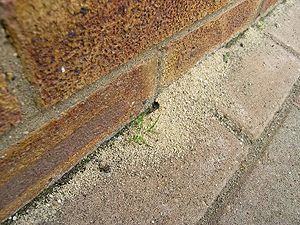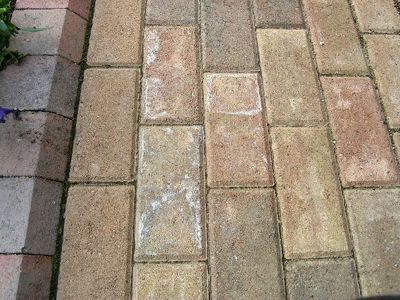Page 1 of 2
Posted: Mon May 03, 2004 1:50 pm
by steve r
Hi Tony
hope you are well.
The forum appears to be a pratt free zone at the moment.
I have a problem with ants digging out my jointing sand where the blocks meet the house and kerbs.
Have sent a pic taken with my new leccy camera to info at.
I dusted the area with ant powder which got rid of them for a while but now they are back in force accompanied by a small beetle like thing about 4mm long with a multi coloured translucent body.
I think I need to rake out the sand and redust the joints.
My worry is the blocks may move into the void without any restraint.
Is there a liquid ant killer available that would penetrate the sand?
ps did you see the plug for your site in the Sunday Times yesterday?
Regard
Steve
Posted: Wed May 05, 2004 5:35 pm
by 84-1093879891
Good to hear from you again, Steve. I thought Wickford had fallen off the map! ;)
In my garden, when I want to get shut of ants I use a mix of borax and syrup. The trick is that the ants lap up the syrup'n'borax, take it back to the queen and it bungs her up, wiping out the colony. Borax is the basis of most of the commercially available ant-killing preparations.
However, for a driveway, I'm not sure how practical this might be and me preferred solution would be to use a joint stabilising compound of some kind. The simplest offerings 'glue together' the jointing sand making it more resistant to mining without affecting the finished appearance of the blocks themselves.
The other alternative is to use a sealant. This will have the added "benefit" (as some would see it) of protecting your driveway from any stains or spillages (such as oil from rogue Shoguns!) as well as binding the jointing sand. There are matt(ish) sealnats, not just the high-gloss shiny stuff that seems to be most popular.
Which sounds most interesting to you?
I didn't see the bit in the Times - I don't read the Sunday Times (Sunday is the one day of the week I don't get a paper), and they never warned me that I was about to be 'featured'. Can you send me a scan?
I know the site appears in magazines from time to time, the best being in a mag last year which featured a scantily clad Suzi Perry (her of the motorbike persuasions). I'm not sure if anyone ever noticed my website lurking behind the obvious charms of the delightful Ms Perry, but it was a good excuse to buy the mag! :)
Posted: Thu May 06, 2004 11:35 am
by steve r
Thanks Tony
If you have a look at my pic (sent to info@) you will see that the beggars have oiked the sand out from the joints, and if I make it sticky with syrup I'll have a problem getting it back.
The sealant idea seems the best long term solution but I need to evict the ants first and resand the joints.
The blocks are still suffering from effloresence which disappears but soon comes back.
The Shogun dribbles disappeared completely after 2 days, only to be replaced by engine oil from the postvan.
The dustman doesn't call till tomorrow so I can scan the paper this evening and send it to you.
Regards
Steve
Posted: Thu May 06, 2004 1:43 pm
by 84-1093879891
I was looking at some block paving in Shaftesbury in Wiltcestershire on Tuesday, and I noticed it seemed to have helluva a lot of efflorescence. The blocks were Brett's Alpha, not too dissimilar to what you have, and the client reckons they've been like that since they were laid last summer. This is not the first time this problem has been mentioned in relation to this one manufacturer - maybe it's a weakness of their production process, which I'm sure they'll deny, but it does need looking at, I feel.
I was visiting another block making plant recently and their production manager told me they were using 'cool steam' (around 40 degrees or a bit more) in the curing chamber for the first few hours and it was all but eliminating problems with eff. on the cured blocks.
Anyway, back to your problems. You can put the syrup/borax mix on a piece of plastic or an old suacer/paint can lid so that it doesn't contaminate your paving, or you could try one of the powder form ant-killers (which'll be icing sugar and borax, prob'ly!).
Ackshirley, if you're not overly worried about the Animal Liberation Front coming down on you, you could seal the pavement with the ants inside it, and they'd never get out (well, not through the surface, anyway!). However, I'd want to see the last of the eff. gone before committing a sealant to the surface, so, at this stage, a joint stabilising solution might be the best option just now.
Have you any pics of the eff-stained driveway?
Posted: Thu May 06, 2004 1:47 pm
by 84-1093879891
Ooops...here's the photo of the ant-mining that Steve sent to me....

Posted: Thu May 06, 2004 7:32 pm
by steve r
Tried 2 chemists today and they both said sorry we don't sell borax any more, so will have another go tomorrow.
Have sent some pics to the usual addresss.
I wonder, if the marks are just salts on the surface, a power wash may speed things up.
Regards
Steve
Posted: Fri May 07, 2004 11:45 am
by 84-1093879891
I get my Borax from Boots. I think it's actually sold as an aid to laundry - it softens the water or summat.
Power-washing will remove the worst of the eff. because eff is salts. However, as the salts are 'bled' through the surface of the blocks as part of the continuing curing process, it's a good bet that they'll be back again in 2-3 months. There's no harm in trying, though, and you might just find that the blocks are all eff'ed out and removing the deposits from the surface of the blocks is an end to it!
And then a pig will fly directly over the top of your stable block on its way to watch a glacier spread across the gates of hell! ;)
Posted: Fri May 07, 2004 3:18 pm
by steve r
Did you get pics?
Posted: Fri May 07, 2004 9:04 pm
by 84-1093879891
Yes...here's the 'best' image...

...it shows what I call 'contact efflorescence' which seems to occur when blocks are cubed into packs before they are properly cured.
The tell-tale signs are the 'image' of other blocks in the outline of the efflorescence, as though the blocks stacked on top of the affected blocks were daubed in paint and left their mark where they were in contact.
I'm not a manufacturer or a concrete technologist, so I could be wrong about all this, but this phenomenon does seem to affect some manufacturers more than others which leads me to surmise that it is a production issue or a problem with the concrete mix itself. As mentioned before, my suspicion is that the blocks are removed from the curing chamber prematurely and 'cubed', which is the process whereby they are stacked ready to be banded and shrink-wrapped. As the blocks are stacked in direct contact with other blocks, I'm guessing that some degree of 'sweating' takes place, which I think is the root cause of the distinctive pattern to the efflorescence, as distinct from the random eff. seen with other concrete products.
Try the power washer with a stiff brush, let it dry out, top-up the joints with sand, and see how it looks in, say, 4-6 weeks time. I may be down in Essex again by then - if I am, I'll call in for a brew and a nosey. :)
Posted: Sun May 09, 2004 5:53 pm
by steve r
have spent the afternoon trying to clean the blocks, first with just the power washer to no effect, then with a wire brush. This removed some of the stain but no matter how hard I brushed I couldn't get them completly clean.
I think you are right about being specific to certain manufacturers, the kerbs and soldiers,from topave although heavily stained when delivered, were clean within a few weeks.
The main body of the drive is laid in blocks made by Brett.
The areas most affected by staining is taking the least amount of surface water ie between the garage door and the linear drain. This may be why the salts have calcified and can't be removed.
I think the only way forward is to replace the blocks.
What do you think?
I nuked the ants on friday and there doesn't seem to be any more activity from the beggars.
Standing by the kettle.
Steve
Posted: Sun May 09, 2004 6:02 pm
by 84-1093879891
Resiblock make some jollop by the name of ER (which I'm guessing is their secret code for "Eff Remover") which is used to remove "Lime Bloom" (as they describe it) from CBPs.
I've never used it myself, but Resiblock are a reputable company and I can't see them selling summat that doesn't work. I've no idea what it costs, but I can find out, if you like, and see if we can get hold of a sample for you.
Posted: Sun May 09, 2004 6:11 pm
by steve r
Sounds like a good idea, much better than kneeling on wet blocks with a wire brush.
Thanks Steve
Posted: Sun May 09, 2004 6:15 pm
by steve r
A thought has just occured to me!
What about trying a lime scale remover.
Steve
Posted: Mon May 10, 2004 9:10 am
by danensis
Have you tried vinegar?
Posted: Mon May 10, 2004 11:00 am
by 84-1093879891
I'm not sure about lime-scale remover - it depends on "what's in it" - if it's acid-based, i wouldn't put it anywhere near those blocks.
As for vinegar, I've never had much success with it. It seems that the eff is back within days and you can't get rid of the smell of the damned vinegar for weeks. Have you tried it, Jon?

